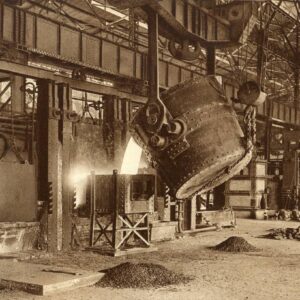Description of events
Industrial complex
Date : –
Address : Altos Hornos de Vizcaya Hiribidea 33
Altos Hornos de Vizcaya was created in 1902 as a result of the merger of Altos Hornos and Factories of Iron and Steel of Bilbao, La Vizcaya and La Iberia.
As Koldobika López explains (pp. 233-252), the history of Barakaldo cannot be understood without this company. In fact, the role of this factory in the war was crucial, since some theories affirm that if it had been destroyed, as proposed by orders from the Government of the Republic, it would have substantially changed the course of victory.
The reasons why it was not destroyed by the Gordexola battalion. They were due to the fact that the managing board of Altos Hornos created schools (Los Hermanos), sponsored schools (Colegio de las Hijas de la Cruz), hospitals (San Eloy), stores, houses and even gave pensions and financial aid to families related to the company. The members of the aforementioned battalion were from Barakaldo and for many of them this company was their only livelihood.
As soon as the war started, the production problems began, at first they were due to the military uprising and later due to the lack of energy (lack of coal). This lack of energy to run the entire factory was a constant throughout the war, making AHV’s production efficiency always below its productive capacity. It is estimated that it was 5%.
Also at this time, the members of the board of directors were purged in order to prevent the company from being left in the hands of sympathizers of the rebels. This materialized with the departure of one or two people. On September 30, 1936, the board of directors received the news of the death of Fernando de Ybarra, member of the board of directors of AHV. He was assassinated in the attacks on the Cabo Cailates prison ship that took place on September 25, 1936, as a direct consequence of the bombardments against the civilian population in Bilbao.
Most of the company management, although they were not purged, were related to the rebellious side, so they did not make great efforts to get coal to the factory and did nothing to avoid or alleviate the hardships that the men of the Gordexola battalion went through. , which had prevented the destruction of AHV.
Once Bilbao fell into Franco’s hands, the directors of Altos Hornos explained in writing that the relations they maintained during the war were purely commercial. In fact, they boasted in writings of trying to sabotage the demands of the Basque Government by slowing down orders.
Altos Hornos was not militarized by the Basque Government nor did it direct its production towards military purposes. Many of the men who worked in this factory before the war and who fought for the Republic were punished by denying them access again.
Between 1938 and 1939, prisoners from the Deusto university concentration camp were provided for industries. The only limitation imposed on slave labor was that prisoners were only granted for specific tasks and periods, never on a stable basis in the same destination.
Altos Hornos de Vizcaya requested 7 prisoners for a refractory material quarry.
Franco visited Barakaldo on different occasions, (June 20, 1939, June 20, 1944, June 21, 1950, August 25, 1958, June 19, 1962 and in October 1962), in some of these visits he he is aware that he visited the Altos Hornos de Vizcaya factory.
SOURCES :
Egaña I. 2009. Franco’s crimes in EuskalHerria 1936-1940 Txalaparta Tafalla (Navarra). (pg. 129-130).
LÓPEZ, Koldobika (2016). The Civil War in Barakaldo. Eleven months of resistance. Bilbao: Beta Editions.
Place reference
BIC Bizkaia Ezkerraldea
Altos Hornos de Vizcaya Hiribidea 33
State of conservation
It currently does not exist.
Where the Ilgner Building is currently located









